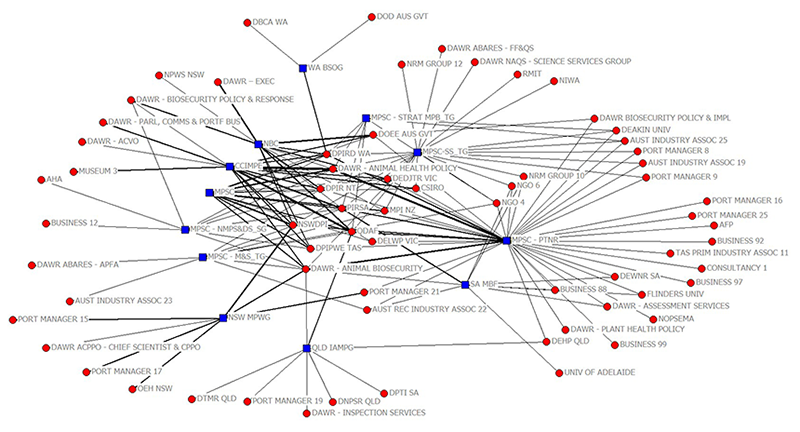An analysis of the Australian marine pest network
Authors: Nyree Stenekes, Heleen Kruger, Ryan R. J. McAllister and Rob Garrard
Source: ABARES marine pest network survey 2018. Note: Blue squares are policy forums and red circles are organisations with individuals attending specific forum events. Tie thickness indicates number of people in an organisation who attended a forum, i.e. the more attendees, the thicker the connecting line.
Executive summary
Background
Marine pests can cause significant negative social, ecological and economic impacts to infrastructure, marine habitats, water quality, marine industries and coastal amenity values. Maintaining an effective marine pest biosecurity system that minimises the risk of marine pests to Australia is a priority for the Australian Government.
The Department of Agriculture commissioned ABARES to investigate the current state of Australia’s marine pest biosecurity stakeholder network by means of a social network analysis.
The analytical approach applied sought to understand whether certain network structures are in place to support key marine pest biosecurity functions. In order to determine the degree to which supporting network structures existed, network analysis techniques were applied that measure:
- Coordination
- Innovation
- Collaboration
Key findings
In essence, the findings identified that the marine pest stakeholder network supports coordination reasonably well. Some characteristics of the network support innovation well, while some areas of the network may benefit from interventions that encourage better innovation. A small amount of evidence was found showing that the network supports collaboration in some instances, and this could be expanded to other parts of the network.
More specifically, the findings of the study provide a broad understanding of the current marine pest stakeholder network by identifying key players in the network and relationships, and patterns of interaction, between them.
The study showed that involvement and interest in marine pest biosecurity is extensive and complex. A wide range of government and non-government organisations and groups participate in the network. The analysis identified opportunities to tap into existing stakeholder networks and build on current structures to further improve network function.
For example, central actors were identified as key points in the network from which to disseminate information about a detection of an invasive marine pest, new marine pest research or to develop surveillance activities and to attain maximum dispersion across the network.
State and territory government agencies were positioned well to disseminate information and broker knowledge, many of these with extensive networks. Some non-government actors, such as marine consultants and businesses also had well developed networks, which appear to be underutilised.
The key gaps in knowledge and information flows across organisations or geographies were identified and offer guidance as to where efforts could be focussed to further build relationships. The analysis revealed various areas of the network were under-developed.
This was particularly the case in the engagement of non-government stakeholders active in the marine environment, such as vessel owners, marine facility operators, natural resource management (NRM) groups, non-government organisations (NGOs), local governments and community groups, who can play a role in preventing, detecting, reporting and managing the impacts of marine pest risks.
Download the report
If you have difficulty accessing this file, visit web accessibility for assistance.
This report was produced by a joint research team from ABARES (Nyree Stenekes and Heleen Kruger) and the Commonwealth Scientific and Industrial Research Organisation ( Ryan R.J. McAllister and Rob Garrard).



